Normandy Scholars Visit D-Day Sites
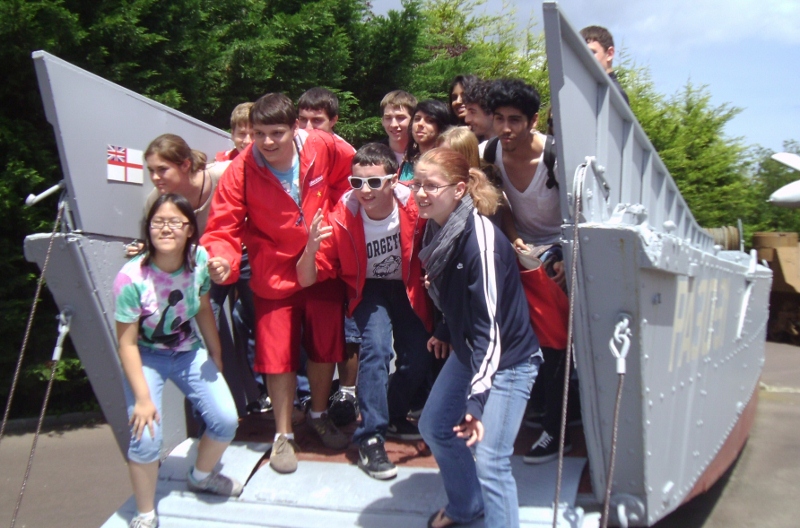
“I feel that medics are truly heroes,” said Joseph Landoni of Sequim, Washington as he delivered a briefing on medics at The Museum of the Atlantic Wall – The Grand Bunker on Saturday. As he spoke to the mixed group of his peers, teachers and National History Day staff, a German bunker overlooking Sword Beach loomed behind him. Joseph has chosen to honor Terrence D. Cosgriff of Washington, who served as a medic in the 119th Anti-Aircraft Battalion
Joseph’s briefing was one of the first given by the Normandy Scholars on their trip to France. On Friday, June 22, the fifteen Normandy Scholars and their teachers landed in Paris. After a three-hour bus ride, they were in Normandy to investigate the campaigns in which their chosen soldiers took part.
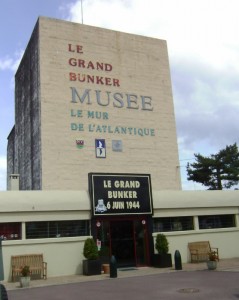
- A former German bunker that overlooks Joseph’s briefing
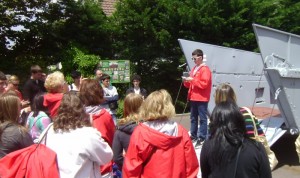 Joseph Landoni delivers a briefing on medics from a landing craft |
Their first stop was Pegasus Bridge, the sight of the first Allied victory on D-Day. The students took note of the precision displayed by the glider pilots of the British 6th Airborne Division as three gliders landed within 100 meters of the bridge, a critical objective. The group then toured the Memorial Pegasus and walked across the Pegasus Bridge that spanned the Caen Canal in 1944. This bridge is now behind the Memorial as it was replaced by a nearly identical bridge in 1994.
Later in the day, the students investigated the German artillery battery at Longues-sur-Mer and the ruins of Mulberry ‘B.’ At each of these stops, one of the students was chosen to deliver a briefing on a Normandy topic. Joseph delivered the briefing on medics, while Tiffany Shumack of San Diego discussed the airborne campaigns and Erick Chavez of Washington DC spoke on the resupply mission and the role of African Americans in unloading and delivering vital supplies.
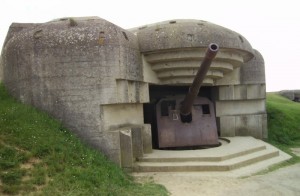 German Battery on Longues-sur-Mer |
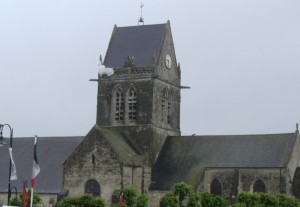 The church in Ste Mere Eglise |
On Sunday, the day began with a visit to the town of Ste. Mere Eglise. Kalie Indest of New Orleans stood in the area where Sgt. John P. Ray, the soldier she has chosen to honor, landed and was fatally wounded by a German soldier. She delivered a briefing on the importance of capturing Ste. Mere Eglise near that landing spot. The group then toured the church where John Steele of the 82nd Airborne became stuck on the steeple before he was cut down by Germans and taken prisoner. Inside the Airborne Museum across the street. Jason Lewis of Salem, Indiana gave a briefing on the 377th Parachute Field Artillery in Normandy from underneath the wing of a C-47.
On a rainy, muddy afternoon, the group then traveled to a spot near the town of St-Lo to gain insight on fighting in the bocage. The students walked down a sunken road for nearly a quarter of a mile and peered through the dense hedgerows into the fields. This experience led to a much greater appreciation for the difficult fighting that Allies soldiers faced in the days and weeks after D-Day. Jake Eden of Algona, Iowa took note of this as he delivered his briefing on fighting in the bocage after this walk. Jake has chosen to honor Sgt. James H. McMahon who was killed while fighting in the hedgerows.
Monday’s travels will bring visits to Omaha Beach Utah Beach, and Pointe du Hoc. More students will deliver their briefings and prepare themselves to deliver their eulogies to their fallen soldiers on Tuesday at the Normandy American Cemetery.
This post by Louisiana History Day Coordinator Nathan Huegen
- Posted :
- Post Category :
- Tags : Tags: Memorial Day, Normandy, Normandy Scholars
- Follow responses to this entry through the RSS 2.0 feed. You can skip to the end and leave a response. Pinging is currently not allowed.




Leave a Reply